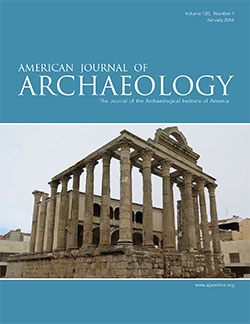AJA Open Access
BY-NCJanuary 2016 (120.1)
Book Review
World Antiquarianism: Comparative Perspectives
Edited by Alain Schnapp
Reviewed by Stephen L. Dyson
This volume publishes a group of papers that explore the topic of antiquarianism as it manifested in different time periods and in diverse geographical and cultural areas from Europe through Asia, Oceania, and to the New World. The collection originated from a conference held at the Getty Research Institute in 2010.
While the title suggests that this collection would be a wide-ranging investigation of comparative perspectives on world antiquarianism, the reality is rather more restricted and conventional. Geographical coverage is limited in both range and depth. There are only single contributions on such topics as preliterate societies (Murray), photography and ethnography (Küchler), ancient Egypt (Wendrich), ancient Mesopotamia (Beaulieu), pre-Columbian Mesoamerica (Luján), and the Islamic world (Cooperson). There are two essays on the classical world (Schnapp, Rojas) and the Indian subcontinent (Subrahmanyam, Lahiri). The two most substantial sections center on the European antiquarian tradition (Miller, Meier, Stenhouse, Ceserani) and east Asia (von Falkenhausen, Sena, Hsu, Lachaud, Bai, Suzuki).
I must admit that I have serious reservations about the success of this collection in providing a comprehensive picture of contemporary antiquarian research. The first concern arises from the authors’ rather vague and limited conceptualization of the term “antiquarianism,” which is especially manifest in the papers concerned with post-Antique Europe. That deficiency was surprising, since the editor (Schnapp) has made such important contributions to our understanding of the European tradition of antiquarianism.
A key source in defining the discourse for a number of the authors was an article by Momigliano on antiquarianism (“Ancient History and the Antiquarian,” Journal of the Warburg and Courtauld Institutes 13 [1950] 285–315), which helped to stimulate a new appreciation of the contributions of the antiquarians to historical scholarship. However, the study of antiquarianism has advanced greatly in the six decades since that publication. Too often the authors in this volume treat that piece with a sense of authority that makes it sacred text rather than a starting point for new research and new historical discourses.
There is also in the European section a restriction in chronological range and an undercurrent of elitism, which limits new and innovative explorations of the topic. Most of that section’s presentations are set within a Renaissance to 18th-century time frame. In a sense, this is an area of antiquarian research for which there is less new to say. Much presented here has the ring of the familiar.
Reading these essays, one might come to the conclusion that the western antiquarian world came to an end with Napoleon. Yet as Levine has demonstrated in The Amateur and the Professional: Antiquarians, Historians and Archaeologists in Victorian England 1838–1886 (Cambridge 1986), antiquarian culture remained vigorous well into the 19th century. In some fields, such as the study of Roman Britain, antiquarian research remained vital for much of the 20th century. This was the antiquarian world with the great geographical scope, embracing most of Europe and important parts of the Americas. It included small-town lawyers and country parsons but also very serious antiquarians who supported such associations as the Society of Antiquaries of London or the active and important antiquarian pursuits of scholars and savants of early 19th-century Rome. That important part of antiquarian history clearly did not appeal to the organizers of this conference. However, for a work that is titled World Antiquarianism, such omissions are serious.
As noted above, there is also a certain vagueness in the use of the concept of antiquarianism itself in many parts of the work. The articles centered on cultural areas such as Mesopotamia and Mesoamerica focus on the reuse of relics from the past in later civic or religious contexts. In such situations, there seems to have been a very intentional religious and/or ideological agenda. Was that not the case with an English parson collecting brass rubbings or a French small-town lawyer collecting Merovingian coins? The contrast called for a broader discussion of the range of meanings included within the term “antiquarianism.” Other important manifestations of European antiquarianism are omitted. Especially relevant would have been the ongoing debate about the use of spolia in civic and religious contexts in Europe. Significantly, the term “spolia” does not appear in the index.
While the chapters concerned with Europe embody many of those limitations, those centered on east Asia present a much wider vision of the antiquarian world. There are informative studies of Chinese and Japanese antiquarianism in the centuries before many strands of modernism challenged the two societies and the antiquarian cultures that were so central to their elite intellectual life. Nor is more recent antiquarianism neglected. The essays on Quanshen Bai and Hiroyuki Suzuki provide touching pictures of scholars pursuing successfully and unsuccessfully their ancient hobby in a changing world with new political agendas and new challenges coming from the European, more “scientific” study of the past.
The book preparation is competent. The number, range, and quality of the illustrations are rather limited, especially for a subject that is so related to the visual. Most missed is a systematic bibliography. Readers may want to pursue further unfamiliar topics presented in the individual essays; the lack of a comprehensive bibliography makes that difficult. In the end, I left this book having learned much, but with a sense of lost opportunity. New research and changes in scholarly attitudes toward antiquarianism offer exciting new fields for exploration. Some of this is incorporated in the work; yet, much is not.
Stephen L. Dyson
Department of Classics
University at Buffalo
